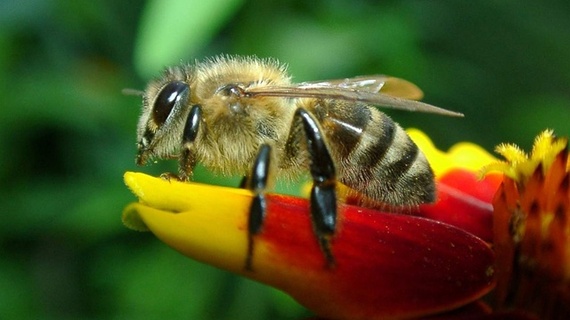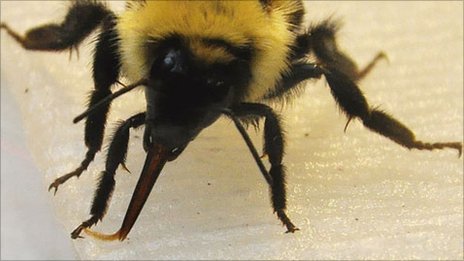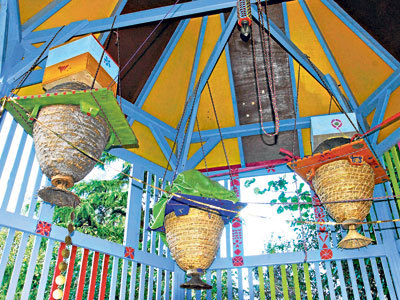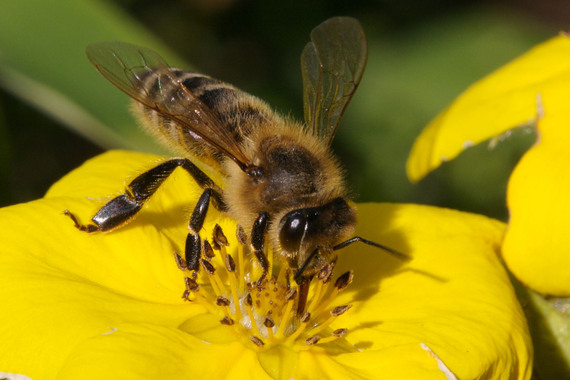Honeybees are incredible creatures. They are now being used in a massive military cleanup in Western Europe.
Join Earth Dr Reese Halter for another SOS segment as he explains honeybees protecting children and sniffer-dogs from lethal landmines.
Honeybees pollinate most of the food we eat and all of the cotton we wear. Each year, honeybees also produce an astounding 2.65 billion pounds of honey.
The story of the first honeybee began at least 100 million years ago - thus, it's a story 14 times older than that of the first human progenitor. Photo credit: abc.net.au
Normally, a forager honeybee dies because after flying 500 miles in three weeks and visiting almost a million flowers, she wears her wings out. Or put another way, she works herself to death.
These admirable creatures can count to four, and they can be trained to arrive at three, four and five separate periods during 24 hours.
For the past 15 years, scientists have been training honeybees to identify over 60 different odors ranging from tuberculosis (TB) to enriched uranium, methamphetamine (crystal meth) and TNT (the main explosive in landmines).
In order to get the bees to identify a scent, the chemicals are mixed into a sugary liquid laced with a hit of caffeine, which the bees are rewarded with. The process is repeated up to five times, by which point the bees associate the smell with the food. Photo credit bbc.co.uk
The Red Cross estimates that between 50 and 100 million landmines exist in 80 countries, maiming 22,000 people (mostly children) every year.
It is every child's birthright to play in safe fields with clean air, clean water and healthy soils. All 20,000 known species of bees play an integral role in pollinating 200,000 flowering plants thus ensuring the global health of our terrestrial biodiversity. Photo credit: the guardian.com
Biologists from France and Croatia have successfully trained honeybees to become "sniffer bees" to swiftly pinpoint these deadly explosive devices scattered throughout the Balkans. In fact, honeybees are now being used instead of sniffer-dogs to find over 120,000 unexploded landmines in over 9,400 sites left behind from the 1992-95 Bosnian War. And after a couple days of sniffing duty, they can be returned, unharmed, to the hive.
Sniffer-dogs cost about $9,000 each, are accurate approximately 71 percent of the time and require three months of training. Honeybees, on the other hand, are accurate 98 percent of the time, require less than 10 minutes of training, and they will prevent sniffer-dogs from being maimed by landmines.
By finding those unexploded landmines, our friends the honeybees will prevent thousands of children playing in Balkan fields from also being maimed.

Patients breathe into a glass diagnostic tool, and when the trained bees detects the smell of any of the diseases or hormones they move toward the tube that lead closer to the mouth. Photo credit: Susana Soares
By the way, honeybees are also being used as early frontline detectors of lung and skin cancers, diabetes, TB, as well as monitoring fertility cycles and confirming pregnancies.
Quite simply, humans cannot live without honeybees, yet these remarkably complex creatures can easily exist without our species. Currently, honeybees are dying by the tens of billions around the globe.
The Sun Hive is a biodynamic initiative of the Natural Beekeeping Trust in the UK. Based on an ingenious combination of skep baskets made of rye straw and wooden support structures, the Sun Hive is intended to be installed at a height of at least 8 feet. The shape of the hive harmonizes with the movement gesture of the bee colony and enables the bees to design their brood nests according to their own innate criteria. The hive was designed by German sculptor, Guenther Mancke, and represents the fruits of many years of research into the nature of the honeybee colony. Photo credit. NaturalBeekeepingTrust.org
It's time that we help our incomparable partners the honeybees by allowing them to eat honey, rather than robbing them of all their honey and sentencing them to an impoverished diet of corn syrup. Furthermore, my colleagues have irrefutably shown that using 1.6 billion pounds annually of a known bee-killing class of insecticides called neonicotinoids is not only contaminating fresh waterways and soils, it's diminishing Earth's biodiversity and placing our global food security in dire jeopardy.
A forager honeybee's head has two antennae loaded with 3,000 sensory organs. Their ability to distinguish between 170 odors is vital for smelling nectar, pollen, water, tree resin and alert pheromones. Photo credit: theguardian.com
___________
Earth Dr Reese Halter is a broadcaster, biologist, educator and author of The Incomparable Honeybee and the Economics of Pollination.





